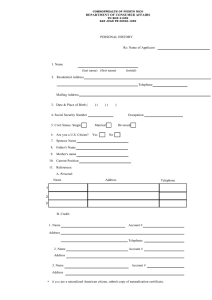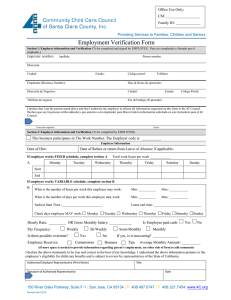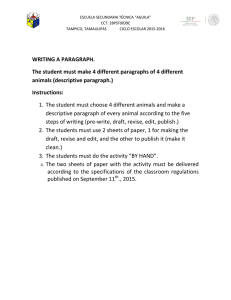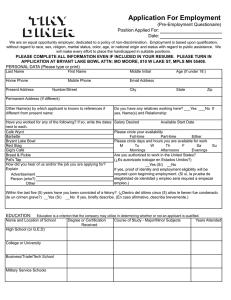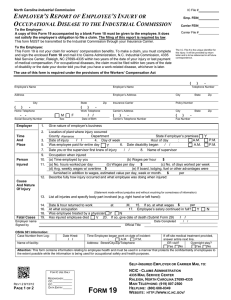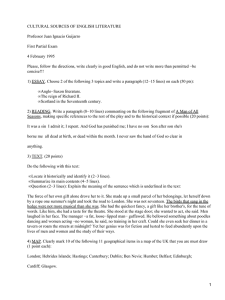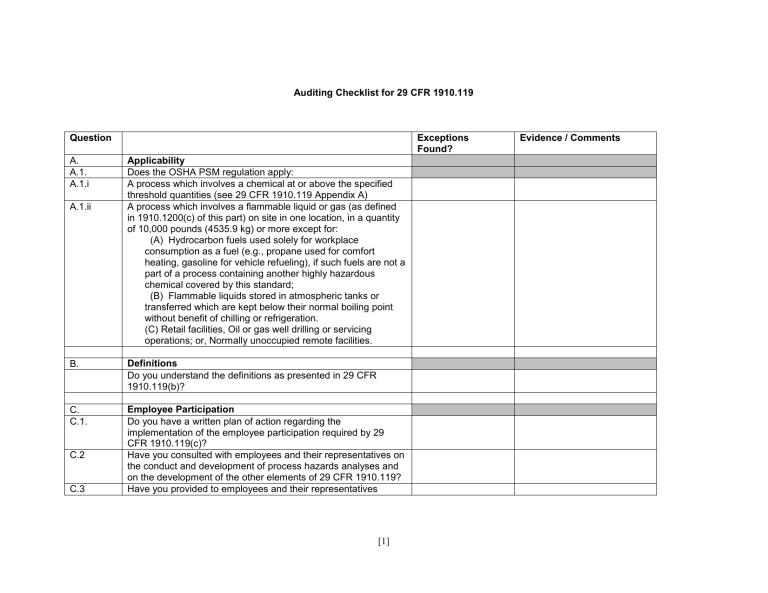
Auditing Checklist for 29 CFR 1910.119 Question A. A.1. A.1.i A.1.ii Exceptions Found? Applicability Does the OSHA PSM regulation apply: A process which involves a chemical at or above the specified threshold quantities (see 29 CFR 1910.119 Appendix A) A process which involves a flammable liquid or gas (as defined in 1910.1200(c) of this part) on site in one location, in a quantity of 10,000 pounds (4535.9 kg) or more except for: (A) Hydrocarbon fuels used solely for workplace consumption as a fuel (e.g., propane used for comfort heating, gasoline for vehicle refueling), if such fuels are not a part of a process containing another highly hazardous chemical covered by this standard; (B) Flammable liquids stored in atmospheric tanks or transferred which are kept below their normal boiling point without benefit of chilling or refrigeration. (C) Retail facilities, Oil or gas well drilling or servicing operations; or, Normally unoccupied remote facilities. B. Definitions Do you understand the definitions as presented in 29 CFR 1910.119(b)? C. C.1. Employee Participation Do you have a written plan of action regarding the implementation of the employee participation required by 29 CFR 1910.119(c)? Have you consulted with employees and their representatives on the conduct and development of process hazards analyses and on the development of the other elements of 29 CFR 1910.119? Have you provided to employees and their representatives C.2 C.3 [1] Evidence / Comments Question Exceptions Found? access to process hazard analyses and to all other information required to be developed under 29 CFR 1910.119? D. D.1 D.1.i D.1.ii D.1.iii D.1.iv D.1.v D.1.vi D.1.vii D.2 D.2.i D.2.ii D.3 D.3.i Process safety information. Has the following information been compiled and updated according to the schedule given in 29CFR1910.119(e)? Toxicity information Permissible exposure limits Physical data Reactivity data Corrosivity data Thermal and chemical stability data Hazardous effects of inadvertent mixing of different materials that could foreseeably occur Information pertaining to the technology of the process. Information concerning the technology of the process shall include at least the following: (A) A block flow diagram or simplified process flow diagram (see Appendix B to this section); (B) Process chemistry; (C) Maximum intended inventory; (D) Safe upper and lower limits for such items as temperatures, pressures, flows or compositions; and, (E) An evaluation of the consequences of deviations, including those affecting the safety and health of employees. Where the original technical information no longer exists, such information may be developed in conjunction with the process hazard analysis in sufficient detail to support the analysis Information pertaining to the equipment in the process. Information pertaining to the equipment in the process shall include: (A) Materials of construction; (B) Piping and instrument diagrams (P&ID's); (C) Electrical classification; [2] Evidence / Comments Question D.3.ii D.3.iii E. E.1 E.2 E.3 E.3.i E.3.ii Exceptions Found? (D) Relief system design and design basis; (E) Ventilation system design; (F) Design codes and standards employed; (G) Material and energy balances for processes built after May 26, 1992; and, (H) Safety systems (e.g. interlocks, detection or suppression systems). Has the employer documented the ways in which that equipment complies with recognized and generally accepted good engineering practices? For existing equipment designed and constructed in accordance with codes, standards, or practices that are no longer in general use,has the employer shall determine and document that the equipment is designed, maintained, inspected, tested, and operating in a safe manner? Process hazard analysis. Has the employer performed an initial process hazard analysis (hazard evaluation) on processes covered by this standard, that is appropriate to the complexity of the process that identifies, evaluates, and controls the hazards involved in the process? Has the employer shall use one or more of the following methodologies that are appropriate to determine and evaluate the hazards of the process being analyzed? (i) What-If; (ii) Checklist; (iii) What-If/Checklist; (iv) Hazard and Operability Study (HAZOP): (v) Failure Mode and Effects Analysis (FMEA); (vi) Fault Tree Analysis; or (vii) An appropriate equivalent methodology. Has the process hazard analysis addressed: The hazards of the process; The identification of any previous incident which had a likely [3] Evidence / Comments Question E.3.iii E.3.iv E.3.v E.3.vi E.3.vii E.4 E.5 Exceptions Found? potential for catastrophic consequences in the workplace; Engineering and administrative controls applicable to the hazards and their interrelationships such as appropriate application of detection methodologies to provide early warning of releases. (Acceptable detection methods might include process monitoring and control instrumentation with alarms, and detection hardware such as hydrocarbon sensors.); Consequences of failure of engineering and administrative controls; Facility siting; Human factors; and A qualitative evaluation of a range of the possible safety and health effects of failure of controls on employees in the workplace. Has the process hazard analysis been performed by a team with expertise in engineering and process operations, and the team included at least one employee who has experience and knowledge specific to the process being evaluated? Also, was at least one member of the team knowledgeable in the specific process hazard analysis methodology being used? Has the employer established a system to promptly address the team's findings and recommendations; assure that the recommendations are resolved in a timely manner and that the resolution is documented; document what actions are to be taken; complete actions as soon as possible; develop a written schedule of when these actions are to be completed; communicate the actions to operating, maintenance and other employees whose work assignments are in the process and who may be affected by the recommendations or actions? Has the process hazard analysis been updated and revalidated by a team meeting the requirements in paragraph (e)(4) of this section at least every five (5) years after the completion of the initial process hazard analysis, to assure that the process hazard analysis is consistent with the current process? Has the Employer retained process hazards analyses and [4] Evidence / Comments Question Exceptions Found? updates or revalidations for each process covered by this section, as well as the documented resolution of recommendations described in paragraph (e)(5) of this section for the life of the process? F. F.1 F.1.i F.1.ii F.1.iii Operating Procedures Has the employer developed and implemented written operating procedures that provide clear instructions for safely conducting activities involved in each covered process consistent with the process safety information which shall address at least the following elements? Steps for each operating phase: (A) Initial startup; (B) Normal operations; (C) Temporary operations; (D) Emergency shutdown including the conditions under which emergency shutdown is required, and the assignment of shutdown responsibility to qualified operators to ensure that emergency shutdown is executed in a safe and timely manner. (E) Emergency Operations; (F) Normal shutdown; and, (G) Startup following a turnaround, or after an emergency shutdown. Operating limits: (A) Consequences of deviation; and (B) Steps required to correct or avoid deviation. Safety and health considerations: (A) Properties of, and hazards presented by, the chemicals used in the process; (B) Precautions necessary to prevent exposure, including engineering controls, administrative controls, and personal protective equipment; (C) Control measures to be taken if physical contact or airborne exposure occurs; (D) Quality control for raw materials and control of hazardous [5] Evidence / Comments Question F.1.iv F.2 F.3 F.4 G. G.1 G.1.i G.1.ii G.2 Exceptions Found? chemical inventory levels; and, (E) Any special or unique hazards. Safety systems and their functions. Are operating procedures readily accessible to employees who work in or maintain a process? Have the operating procedures been reviewed as often as necessary to assure that they reflect current operating practice, including changes that result from changes in process chemicals, technology, and equipment, and changes to facilities? Has the employer certified annually that these operating procedures are current and accurate? Has the employer developed and implement safe work practices to provide for the control of hazards during operations such as lockout/tagout; confined space entry; opening process equipment or piping; and control over entrance into a facility by maintenance, contractor, laboratory, or other support personnel? Do these safe work practices apply to both employees and contractor employees? Training Initial training. Has each employee presently involved in operating a process, and each employee before being involved in operating a newly assigned process been trained in an overview of the process and in the operating procedures as specified in paragraph (f) of this section? Has the training included emphasis on the specific safety and health hazards, emergency operations including shutdown, and safe work practices applicable to the employee's job tasks? In lieu of initial training for those employees already involved in operating a process on May 26, 1992, has the employer certified in writing that the employee has the required knowledge, skills, and abilities to safely carry out the duties and responsibilities as specified in the operating procedures? Has refresher training been provided at least every three years, [6] Evidence / Comments Question G.3 H. H.1 H.2 H.2.i H.2.ii H.2.iii H.2.iv H.2.v Exceptions Found? and more often if necessary, to each employee involved in operating a process to assure that the employee understands and adheres to the current operating procedures of the process? Has the employer, in consultation with the employees involved in operating the process, determined the appropriate frequency of refresher training? Has the employer ascertained that each employee involved in operating a process has received and understood the training required by this paragraph? Has the employer prepared a record which contains the identity of the employee, the date of training, and the means used to verify that the employee understood the training? Contractors Application. NOTE: This paragraph applies to contractors performing maintenance or repair, turnaround, major renovation, or specialty work on or adjacent to a covered process. It does not apply to contractors providing incidental services which do not influence process safety, such as janitorial work, food and drink services, laundry, delivery or other supply services. Employer responsibilities. Has the employer, when selecting a contractor, obtained and evaluated information regarding the contract employer's safety performance and programs? Has the employer informed contract employers of the known potential fire, explosion, or toxic release hazards related to the contractor's work and the process? Has the employer explained to contract employers the applicable provisions of the emergency action plan required by paragraph (n) of this section? Has the employer developed and implement safe work practices consistent with paragraph (f)(4) of this section, to control the entrance, presence and exit of contract employers and contract employees in covered process areas? Has the employer periodically evaluated the performance of [7] Evidence / Comments Question H.2.vi H.3 H.3.i H.3.ii H.3.iii H.3.iv H.3.v I I.1 I.2 I.2.i Exceptions Found? contract employers in fulfilling their obligations as specified in paragraph (h)(3) of this section? Has the employer maintained a contract employee injury and illness log related to the contractor's work in process areas? Contract employer responsibilities. Has the contract employer assured that each contract employee is trained in the work practices necessary to safely perform his/her job? Has the contract employer assured that each contract employee is instructed in the known potential fire, explosion, or toxic release hazards related to his/her job and the process, and the applicable provisions of the emergency action plan? Has the contract employer documented that each contract employee has received and understood the training required by this paragraph? Has the contract employer prepared a record which contains the identity of the contract employee, the date of training, and the means used to verify that the employee understood the training? Has the contract employer assured that each contract employee follows the safety rules of the facility including the safe work practices required by paragraph (f)(4) of this section? Has the contract employer advised the employer of any unique hazards presented by the contract employer's work, or of any hazards found by the contract employer's work? Pre-startup safety review Has the employer performed a pre-startup safety review for new facilities and for modified facilities when the modification is significant enough to require a change in the process safety information? Has the pre-startup safety review confirmed that prior to the introduction of highly hazardous chemicals to a process: Construction and equipment is in accordance with design specifications [8] Evidence / Comments Question I.2.ii I.2.iii I.2.iv J. J.1 J.1.i J.1.ii J.1.iii J.1.iv J.1.v J.1.vi J.2 J.3 J.4 J.4.i J.4.ii J.4.iii Exceptions Found? Safety, operating, maintenance, and emergency procedures are in place and are adequate; For new facilities, a process hazard analysis has been performed and recommendations have been resolved or implemented before startup; and modified facilities meet the requirements contained in management of change, paragraph (l). Training of each employee involved in operating a process has been completed. Mechanical integrity. Application. NOTE: Paragraphs (j)(2) through (j)(6) of this section apply to the following process equipment: Pressure vessels and storage tanks; Piping systems (including piping components such as valves); Relief and vent systems and devices; Emergency shutdown systems; Controls (including monitoring devices and sensors, alarms, and interlocks) and, Pumps. Written Procedures. Has the employer established and implemented written procedures to maintain the on-going integrity of process equipment? Training for process maintenance activities. Has the employer trained each employee involved in maintaining the on-going integrity of process equipment in an overview of that process and its hazards and in the procedures applicable to the employee's job tasks to assure that the employee can perform the job tasks in a safe manner? Inspection and testing. Have inspections and tests shall be performed on process equipment? Have the inspection and testing procedures followed recognized and generally accepted good engineering practice? Is the frequency of inspections and tests of process equipment [9] Evidence / Comments Question J.4.iv J.5 J.6 J.6.i J.6.ii J.6.iii K K.1 k.2 Exceptions Found? consistent with applicable manufacturers' recommendations and good engineering practices, and more frequently if determined to be necessary by prior operating experience? Has the employer documented each inspection and test that has been performed on process equipment? Does the documentation identify the date of the inspection or test, the name of the person who performed the inspection or test, the serial number or other identifier of the equipment on which the inspection or test was performed, a description of the inspection or test performed, and the results of the inspection or test? Equipment deficiencies. Has the employer corrected deficiencies in equipment that are outside acceptable limits (defined by the process safety information in paragraph (d) of this section) before further use or in a safe and timely manner when necessary means are taken to assure safe operation? Quality assurance In the construction of new plants and equipment, has the employer assured that equipment as it is fabricated is suitable for the process application for which they will be used? Have appropriate checks and inspections been performed to assure that equipment is installed properly and consistent with design specifications and the manufacturer's instructions? Has the employer assured that maintenance materials, spare parts and equipment are suitable for the process application for which they will be used? Hot work permit Does the employer shall issue hot work permits for hot work operations conducted on or near a covered process? Do the permits document that the fire prevention and protection requirements in 29 CFR 1910.252(a) have been implemented prior to beginning the hot work operations; indicate the date(s) authorized for hot work; and identify the object on which hot work is to be performed? Have the permits been kept on file until [10] Evidence / Comments Question Exceptions Found? completion of the hot work operations? L. L.1 L.2 L.2.i L.2.ii L.2.iii L.2.iv L.2.v L.3 L.4 L.5 M. M.1 M.2 M.3 Management of Change Has the employer established and implemented written procedures to manage changes (except for "replacements in kind") to process chemicals, technology, equipment, and procedures; and, changes to facilities that affect a covered process? Do the procedures assure that the following considerations are addressed prior to any change: The technical basis for the proposed change; Impact of change on safety and health; Modifications to operating procedures; Necessary time period for the change; and, Authorization requirements for the proposed change. Are employees involved in operating a process and maintenance and contract employees whose job tasks will be affected by a change in the process informed of, and trained in, the change prior to start-up of the process or affected part of the process? When changes covered by this paragraph resulted in a change in the process safety information required by paragraph (d) of this section, was such information shall be updated accordingly? When changes covered by this paragraph resulted in a change in the operating procedures or practices required by paragraph (f) of this section, were such procedures or practices updated accordingly? Incident Investigation Has the employer investigated each incident which resulted in, or could reasonably have resulted in a catastrophic release of highly hazardous chemical in the workplace? If so, was the incident investigation initiated as promptly as possible, but not later than 48 hours following the incident? Was the incident investigation team established, consisting of at [11] Evidence / Comments Question M.4 M.4.i M.4.ii M.4.iii M.4.iv M.4.v M.5 M.6 M.7 Exceptions Found? least one person knowledgeable in the process involved, including a contract employee if the incident involved work of the contractor, and other persons with appropriate knowledge and experience to thoroughly investigate and analyze the incident? Was a report prepared at the conclusion of the investigation which included at a minimum?: Date of incident; Date investigation began; A description of the incident; The factors that contributed to the incident; and, Any recommendations resulting from the investigation. Did the employer establish a system to promptly address and resolve the incident report findings and recommendations? Did the employer document resolutions and corrective actions? Was the report reviewed with all affected personnel whose job tasks are relevant to the incident findings including contract employees where applicable? Were incident investigation reports been retained for five years? N. Emergency planning and response. Has the employer established and implemented an emergency action plan for the entire plant in accordance with the provisions of 29 CFR 1910.38(a)? In addition, does the emergency action plan include procedures for handling small releases? NOTE: Employers covered under this standard may also be subject to the hazardous waste and emergency response provisions contained in 29 CFR 1910.120(a), (p) and (q). O. O.1 Compliance Audits Has the employer certified that they have evaluated compliance with the provisions of this section at least every three years to verify that the procedures and practices developed under the standard are adequate and are being followed? Has the compliance audit been conducted by at least one person O.2 [12] Evidence / Comments Question O.3 O.4 O.5 P. P.1 P.2 P.3 Exceptions Found? knowledgeable in the process? Has a report of the findings of the audit been developed? Has the employer promptly determined and documented an appropriate response to each of the findings of the compliance audit, and document that deficiencies have been corrected? Has the employer retained the two (2) most recent compliance audit reports? Trade secrets. Has the employer made all information necessary to comply with the section available to those persons responsible for compiling the process safety information (required by paragraph (d) of this section), those assisting in the development of the process hazard analysis (required by paragraph (e) of this section), those responsible for developing the operating procedures (required by paragraph (f) of this section), and those involved in incident investigations (required by paragraph (m) of this section), emergency planning and response (paragraph (n) of this section) and compliance audits (paragraph (o) of this section) without regard to possible trade secret status of such information? Nothing in this paragraph shall preclude the employer from requiring the persons to whom the information is made available under paragraph (p)(1) of this section to enter into confidentiality agreements not to disclose the information as set forth in 29 CFR 1910.1200. Subject to the rules and procedures set forth in 29 CFR 1910.1200(i)(1) through 1910.1200(i)(12), do employees and their designated representatives have access to trade secret information contained within the process hazard analysis and other documents required to be developed by this standard? [13] Evidence / Comments Appendix A to § 1910.119 -- List of Highly Hazardous Chemicals, Toxics and Reactives (Mandatory) Chemical Name CAS* Acetaldehyde Acrolein (2-Propenal) Acrylyl Chloride Allyl Chloride Allylamine Alkylaluminums Ammonia, Anhydrous Ammonia solutions (>44% ammonia by weight) Ammonium Perchlorate Ammonium Permanganate Arsine (also called Arsenic Hydride) Bis(Chloromethyl) Ether Boron Trichloride Boron Trifluoride Bromine Bromine Chloride Bromine Pentafluoride Bromine Trifluoride 3-Bromopropyne (also called Propargyl Bromide) Butyl Hydroperoxide (Tertiary) Butyl Perbenzoate (Tertiary) Carbonyl Chloride (see Phosgene) Carbonyl Fluoride Cellulose Nitrate (concentration >12.6% nitrogen Chlorine Chlorine Dioxide Chlorine Pentrafluoride Chlorine Trifluoride Chlorodiethylaluminum (also called Diethylaluminum Chloride) 75-07-0 107-02-8 814-68-6 107-05-1 107-11-9 Varies 7664-41-7 7664-41-7 7790-98-9 7787-36-2 7784-42-1 542-88-1 10294-34-5 7637-07-2 7726-95-6 13863-41-7 7789-30-2 7787-71-5 106-96-7 75-91-2 614-45-9 75-44-5 353-50-4 9004-70-0 7782-50-5 10049-04-4 13637-63-3 7790-91-2 2500 150 250 1000 1000 5000 10000 15000 7500 7500 100 100 2500 250 1500 1500 2500 15000 100 5000 7500 100 2500 2500 1500 1000 1000 1000 96-10-6 5000 [14] TQ** On Site above TQ Chemical Name CAS* 1-Chloro-2,4-Dinitrobenzene Chloromethyl Methyl Ether Chloropicrin Chloropicrin and Methyl Bromide mixture Chloropicrin and Methyl Chloride mixture Cumene Hydroperoxide Cyanogen Cyanogen Chloride Cyanuric Fluoride Diacetyl Peroxide (Concentration > 70%) Diazomethane Dibenzoyl Peroxide Diborane Dibutyl Peroxide (Tertiary) Dichloro Acetylene Dichlorosilane Diethylzinc Diisopropyl Peroxydicarbonate Dilaluroyl Peroxide Dimethyldichlorosilane Dimethylhydrazine, 1,1Dimethylamine, Anhydrous 2,4-Dinitroaniline Ethyl Methyl Ketone Peroxide (also Methyl Ethyl Ketone Peroxide; concentration > 60%) Ethyl Nitrite Ethylamine Ethylene Fluorohydrin Ethylene Oxide Ethyleneimine Fluorine Formaldehyde (Formalin) Furan 97-00-7 107-30-2 76-06-2 None None 80-15-9 460-19-5 506-77-4 675-14-9 110-22-5 334-88-3 94-36-0 19287-45-7 110-05-4 7572-29-4 4109-96-0 557-20-0 105-64-6 105-74-8 75-78-5 57-14-7 124-40-3 97-02-9 5000 500 500 1500 1500 5000 2500 500 100 5000 500 7500 100 5000 250 2500 10000 7500 7500 1000 1000 2500 5000 1338-23-4 109-95-5 75-04-7 371-62-0 75-21-8 151-56-4 7782-41-4 50-00-0 110-00-9 5000 5000 7500 100 5000 1000 1000 1000 500 [15] TQ** On Site above TQ Chemical Name CAS* Hexafluoroacetone Hydrochloric Acid, Anhydrous Hydrofluoric Acid, Anhydrous Hydrogen Bromide Hydrogen Chloride Hydrogen Cyanide, Anhydrous Hydrogen Fluoride Hydrogen Peroxide (52% by weight or greater) Hydrogen Selenide Hydrogen Sulfide Hydroxylamine Iron, Pentacarbonyl Isopropylamine Ketene Methacrylaldehyde Methacryloyl Chloride Methacryloyloxyethyl Isocyanate Methyl Acrylonitrile Methylamine, Anhydrous Methyl Bromide Methyl Chloride Methyl Chloroformate Methyl Ethyl Ketone Peroxide (concentration > 60%) Methyl Fluoroacetate Methyl Fluorosulfate Methyl Hydrazine Methyl Iodide Methyl Isocyanate Methyl Mercaptan Methyl Vinyl Ketone Methyltrichlorosilane Nickel Carbonly (Nickel Tetracarbonyl) Nitric Acid (94.5% by weight or greater) 684-16-2 7647-01-0 7664-39-3 10035-10-6 7647-01-0 74-90-8 7664-39-3 7722-84-1 7783-07-5 7783-06-4 7803-49-8 13463-40-6 75-31-0 463-51-4 78-85-3 920-46-7 30674-80-7 126-98-7 74-89-5 74-83-9 74-87-3 79-22-1 1338-23-4 453-18-9 421-20-5 60-34-4 74-88-4 624-83-9 74-93-1 79-84-4 75-79-6 13463-39-3 7697-37-2 [16] TQ** 5000 5000 1000 5000 5000 1000 1000 7500 150 1500 2500 250 5000 100 1000 150 100 250 1000 2500 15000 500 5000 100 100 100 7500 250 5000 100 500 150 500 On Site above TQ Chemical Name CAS* Nitric Oxide Nitroaniline (para Nitroaniline Nitromethane Nitrogen Dioxide Nitrogen Oxides (NO; NO(2); N(2)O(4); N(2)O(3)) Nitrogen Tetroxide (also called Nitrogen Peroxide) Nitrogen Trifluoride Nitrogen Trioxide Oleum (65% to 80% by weight; also called Fuming Sulfuric Acid) Osmium Tetroxide Oxygen Difluoride (Fluorine Monoxide) Ozone Pentaborane Peracetic Acid (concentration > 60% Acetic Acid; also called Peroxyacetic Acid) Perchloric Acid (concentration > 60% by weight) Perchloromethyl Mercaptan Perchloryl Fluoride Peroxyacetic Acid (concentration > 60% Acetic Acid; also called Peracetic Acid) Phosgene (also called Carbonyl Chloride) Phosphine (Hydrogen Phosphide) Phosphorus Oxychloride (also called Phosphoryl Chloride) Phosphorus Trichloride Phosphoryl Chloride (also called Phosphorus Oxychloride) Propargyl Bromide Propyl Nitrate Sarin Selenium Hexafluoride Stibine (Antimony Hydride) 10102-43-9 100-01-6 75-52-5 10102-44-0 10102-44-0 10544-72-6 7783-54-2 10544-73-7 250 5000 2500 250 250 250 5000 250 8014-94-7 20816-12-0 7783-41-7 10028-15-6 19624-22-7 1000 100 100 100 100 79-21-0 7601-90-3 594-42-3 7616-94-6 1000 5000 150 5000 79-21-0 75-44-5 7803-51-2 1000 100 100 10025-87-3 7719-12-2 1000 1000 10025-87-3 106-96-7 627-3-4 107-44-8 7783-79-1 7803-52-3 1000 100 2500 100 1000 500 [17] TQ** On Site above TQ Chemical Name CAS* Sulfur Dioxide (liquid) Sulfur Pentafluoride Sulfur Tetrafluoride Sulfur Trioxide (also called Sulfuric Anhydride) Sulfuric Anhydride (also called Sulfur Trioxide) Tellurium Hexafluoride Tetrafluoroethylene Tetrafluorohydrazine Tetramethyl Lead Thionyl Chloride Trichloro (chloromethyl) Silane Trichloro (dichlorophenyl) Silane Trichlorosilane Trifluorochloroethylene Trimethyoxysilane 7446-09-5 5714-22-7 7783-60-0 7446-11-9 7446-11-9 7783-80-4 116-14-3 10036-47-2 75-74-1 7719-09-7 1558-25-4 27137-85-5 10025-78-2 79-38-9 2487-90-3 TQ** On Site above TQ 1000 250 250 1000 1000 250 5000 5000 1000 250 100 2500 5000 10000 1500 * Chemical Abstract Service Number. ** Threshold Quantity in Pounds (Amount necessary to be covered by this standard). This material was produced under grant SH-19479-09-60-F-36 from the Occupational Safety and Health Administration, U.S. Department of Labor. It does not necessarily reflect the views or policies of the U.S. Department of Labor, nor does mention of trade names, commercial products, or organizations imply endorsement by the U.S. Government [18]
